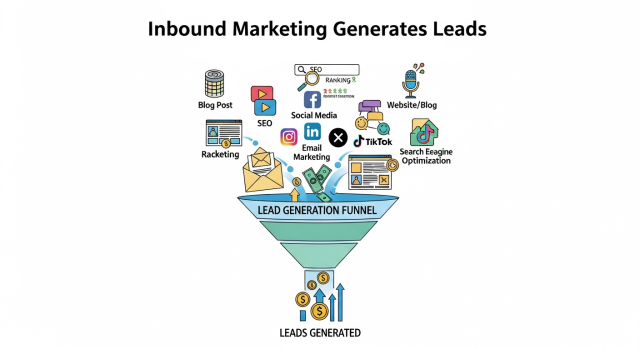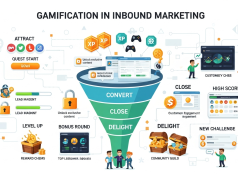Inbound marketing attracts customers by offering valuable content instead of interruptive ads. Using the four-stage funnel—Attract, Convert, Close, and Delight—businesses build trust, nurture leads, and turn customers into brand advocates. By aligning with how modern buyers research and decide, inbound marketing creates sustainable, long-term growth.
Are you tired of chasing down customers? Inbound marketing flips the script. Instead of interrupting potential customers with ads they didn’t ask for, inbound marketing draws them to you with valuable content and tailored experiences. The goal is to build lasting relationships that grow your business.
This approach recognizes that modern buyers are self-directed. They research solutions online long before they ever contact a salesperson. By providing helpful content at each stage of their journey, you position your brand as a trusted advisor. This builds the trust necessary to convert a curious visitor into a paying customer.
The Inbound Methodology: A Four-Stage Funnel
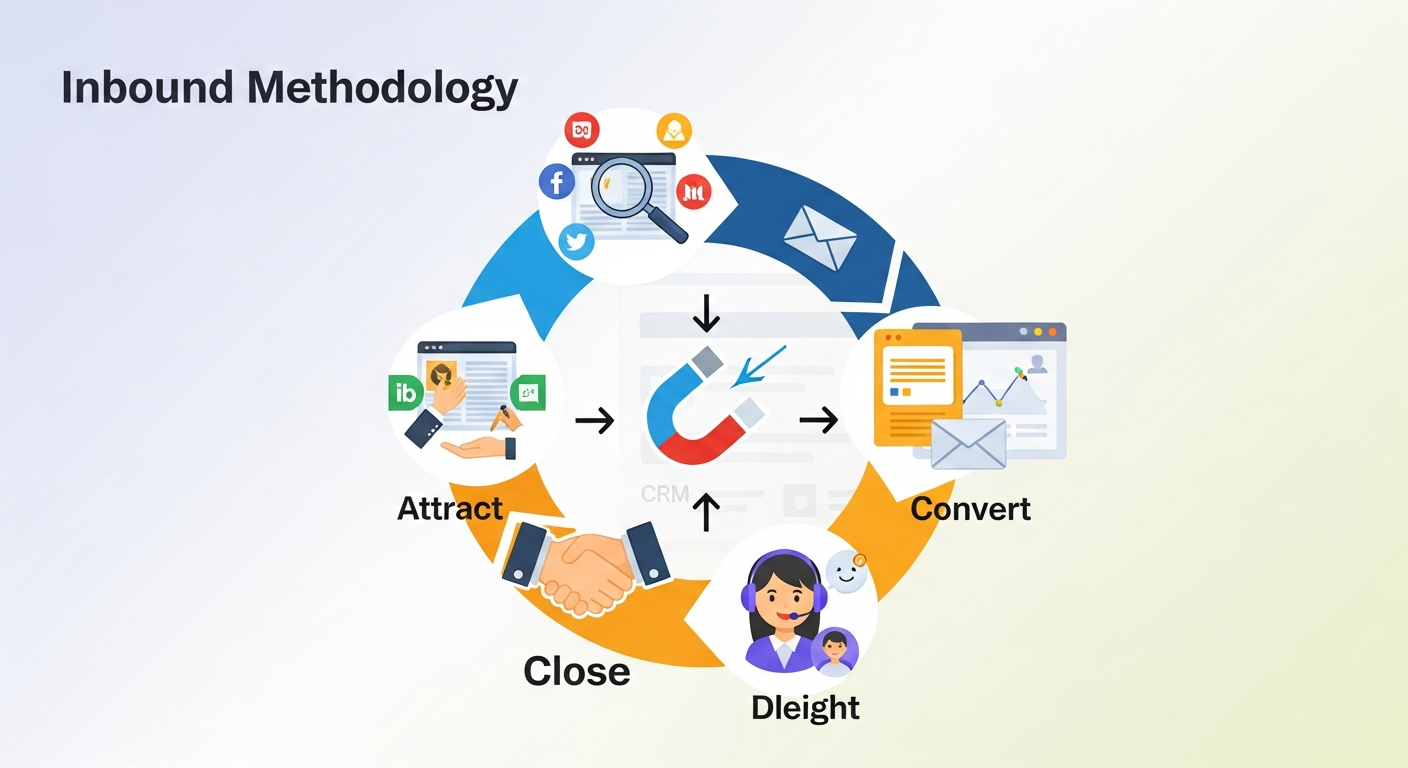
Inbound marketing is often visualized as a funnel (or more recently, a flywheel) with four distinct stages: Attract, Convert, Close, and Delight. Each stage has specific strategies and tools designed to move potential customers closer to a purchase and, eventually, turn them into brand advocates.
Attract: Turning Strangers into Visitors
The first step is to attract your ideal customer—the one who is most likely to benefit from your product or service. This isn’t about getting just any traffic; it’s about getting the right traffic. The key is to create and share content that addresses their problems and answers their questions.
Key Strategies for the Attract Stage:
- Blogging: A well-maintained blog is the cornerstone of inbound marketing. By publishing articles that are optimized for search engines (SEO), you can rank for keywords your target audience is searching for. For example, a financial software company might write posts like “How to Create Your First Business Budget” or “5 Signs You’ve Outgrown Your Accounting Spreadsheet.”
- Search Engine Optimization (SEO): SEO is the practice of improving your website’s visibility on search engines like Google. This involves on-page SEO (optimizing content with keywords), off-page SEO (building backlinks from other reputable sites), and technical SEO (ensuring your site is fast and easy for Google to crawl).
- Social Media Marketing: Share your valuable content on the social media platforms where your audience spends their time. Engage with followers, answer questions, and participate in relevant conversations to build a community and drive traffic back to your website.
- Video Content: Platforms like YouTube and TikTok are powerful search engines in their own right. Creating “how-to” videos, product demos, or expert interviews can attract a wide audience and establish your authority.
Convert: Turning Visitors into Leads
Once you’ve attracted visitors to your site, the next goal is to convert them into leads. This means capturing their contact information, typically an email address. To do this, you need to offer them something valuable in exchange for their details. This offer is known as a “lead magnet.”
Key Strategies for the Convert Stage:
- Lead Magnets: These are high-value resources offered for free. Effective lead magnets include:
-
- Ebooks and white papers
- Checklists and templates
- Webinars and online workshops
- Free trials or demos
- Case studies
- Calls-to-Action (CTAs): A CTA is a button or link that encourages a visitor to take a specific action, like “Download Our Free Guide” or “Sign Up for the Webinar.” CTAs should be visually prominent and use clear, action-oriented language.
- Landing Pages: When a visitor clicks a CTA, they should be taken to a dedicated landing page. This page has one purpose: to persuade the visitor to download the lead magnet. It should have a clear headline, a brief description of the offer’s benefits, and a simple form to collect contact information.
Close: Turning Leads into Customers
Now that you have a list of leads, it’s time to nurture them into customers. Not all leads are ready to buy immediately. The “close” stage involves building a relationship with them, providing further value, and guiding them toward a purchase decision when the time is right.
Key Strategies for the Close Stage:
- Email Marketing: Email is the primary tool for lead nurturing. You can create automated email sequences that send targeted content to leads based on their interests and behaviors. For example, someone who downloaded an ebook on social media marketing could receive a series of emails with more advanced social media tips.
- Customer Relationship Management (CRM): A CRM system helps you track all your interactions with leads. This allows your sales and marketing teams to have a complete view of each lead’s journey, making it easier to personalize communication and identify when a lead is ready to be contacted by sales.
- Lead Scoring: This process involves assigning points to leads based on their demographics and actions (like opening an email or visiting the pricing page). Once a lead reaches a certain score, they are considered “sales-qualified” and can be passed to the sales team.
Delight: Turning Customers into Promoters
Inbound marketing doesn’t stop once a sale is made. The final stage is to delight your existing customers, turning them into repeat buyers and enthusiastic brand advocates. Happy customers can become your most effective marketing channel through word-of-mouth referrals.
Key Strategies for the Delight Stage:
- Excellent Customer Support: Provide timely and helpful support to ensure customers have a positive experience with your product or service.
- Exclusive Content: Continue to provide value to customers with exclusive content, such as advanced user guides, special webinars, or early access to new features.
- Feedback and Surveys: Actively solicit feedback to show customers you value their opinion and are committed to improving. This can also provide valuable testimonials and case studies.
Community Building: Create a community forum or user group where customers can connect with each other and your team, fostering a sense of loyalty and belonging.
Buyer Personas: Understanding Your Ideal Audience
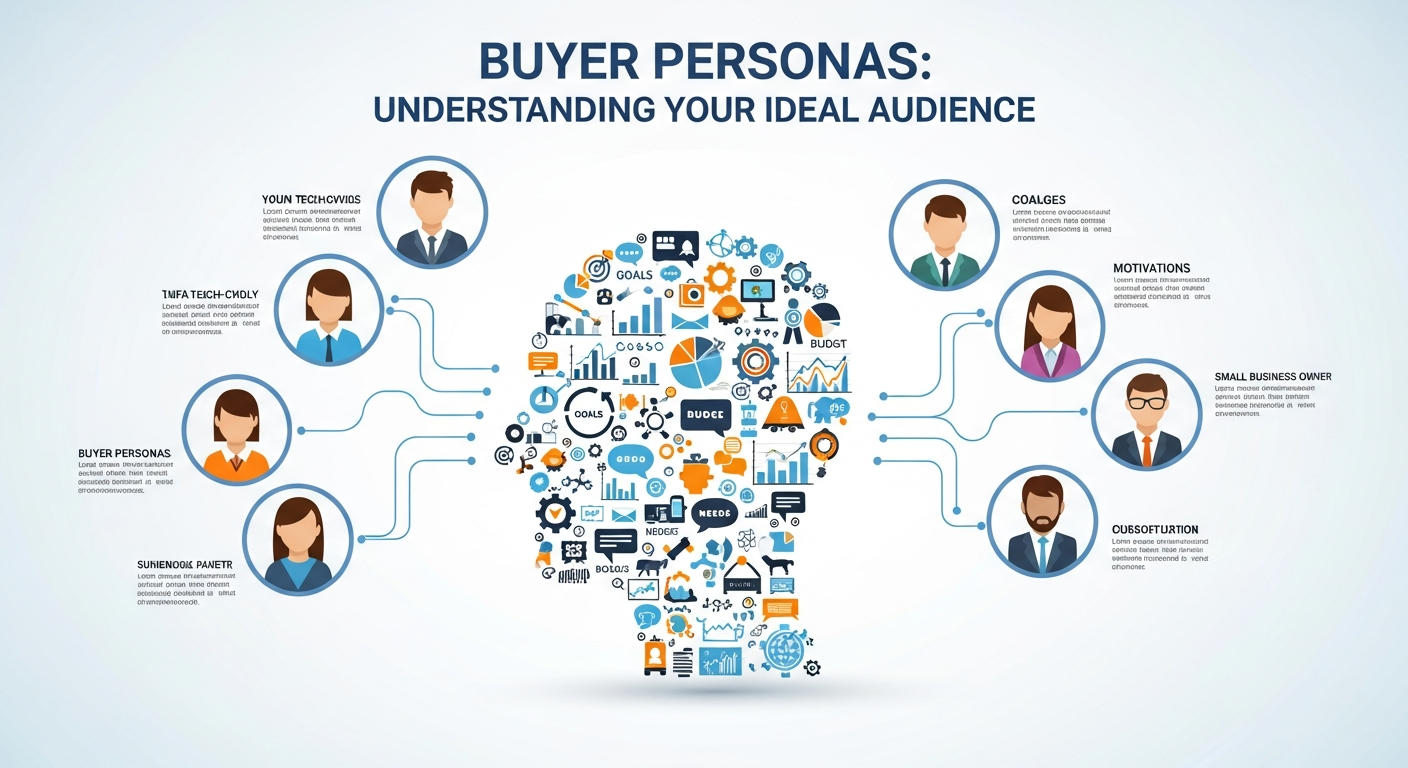
Successful inbound marketing starts with a deep understanding of your ideal customer. Buyer personas are semi-fictional representations of your target audience based on real data, research, and insights. They include information such as demographics, goals, challenges, motivations, and buying behavior. By creating detailed buyer personas, you can tailor your content, messaging, and offers to address specific needs rather than speaking to everyone at once. This ensures your marketing efforts are more relevant and effective. When you understand who you are trying to attract, it becomes easier to create content that resonates, answers real questions, and guides prospects naturally through the buyer’s journey.
Content Mapping: Delivering the Right Message at the Right Time
Content mapping is the process of aligning your content with each stage of the buyer’s journey—awareness, consideration, and decision. Not all prospects need the same information at the same time. Early-stage buyers need educational content, while later-stage buyers look for comparisons, case studies, and product details. By mapping content to these stages, you ensure prospects receive relevant information that helps them move forward confidently. This approach prevents overwhelming users with sales-focused messaging too early and instead builds trust gradually. Effective content mapping improves engagement, increases conversions, and creates a smoother experience throughout the inbound funnel.
Marketing Automation: Scaling Your Inbound Efforts
Marketing automation allows businesses to deliver personalized experiences at scale. Through automated workflows, you can send targeted emails, segment audiences, and respond to user behavior without manual effort. For example, when a visitor downloads a guide, automation can trigger a follow-up email series with related content. This keeps leads engaged while saving time for your team. Automation also ensures consistency, so no lead falls through the cracks. When used strategically, marketing automation enhances lead nurturing, improves conversion rates, and supports sales teams with better-qualified prospects—making inbound marketing more efficient and scalable.
Conversion Rate Optimization (CRO): Maximizing Results
Attracting traffic is only part of inbound marketing; converting that traffic is equally important. Conversion Rate Optimization (CRO) focuses on improving website elements to increase the percentage of visitors who take desired actions. This includes optimizing headlines, CTAs, forms, landing pages, and page layouts. Small changes—such as clearer messaging or simpler forms—can significantly impact results. CRO relies on data, testing, and continuous improvement to understand what works best for your audience. By optimizing conversions, you get more value from existing traffic, improve lead quality, and strengthen the overall performance of your inbound strategy.
Analytics and Reporting: Measuring What Matters
Inbound marketing success depends on data-driven decision-making. Analytics and reporting help you understand how your content and campaigns perform across each stage of the funnel. Key metrics include website traffic, conversion rates, lead sources, email engagement, and customer acquisition costs. By analyzing this data, you can identify what’s working, what needs improvement, and where to focus future efforts. Regular reporting also helps demonstrate ROI and align marketing goals with business objectives. When you consistently measure and refine your strategy, inbound marketing becomes more predictable, effective, and aligned with long-term growth goals.
Sales and Marketing Alignment: Creating a Unified Strategy
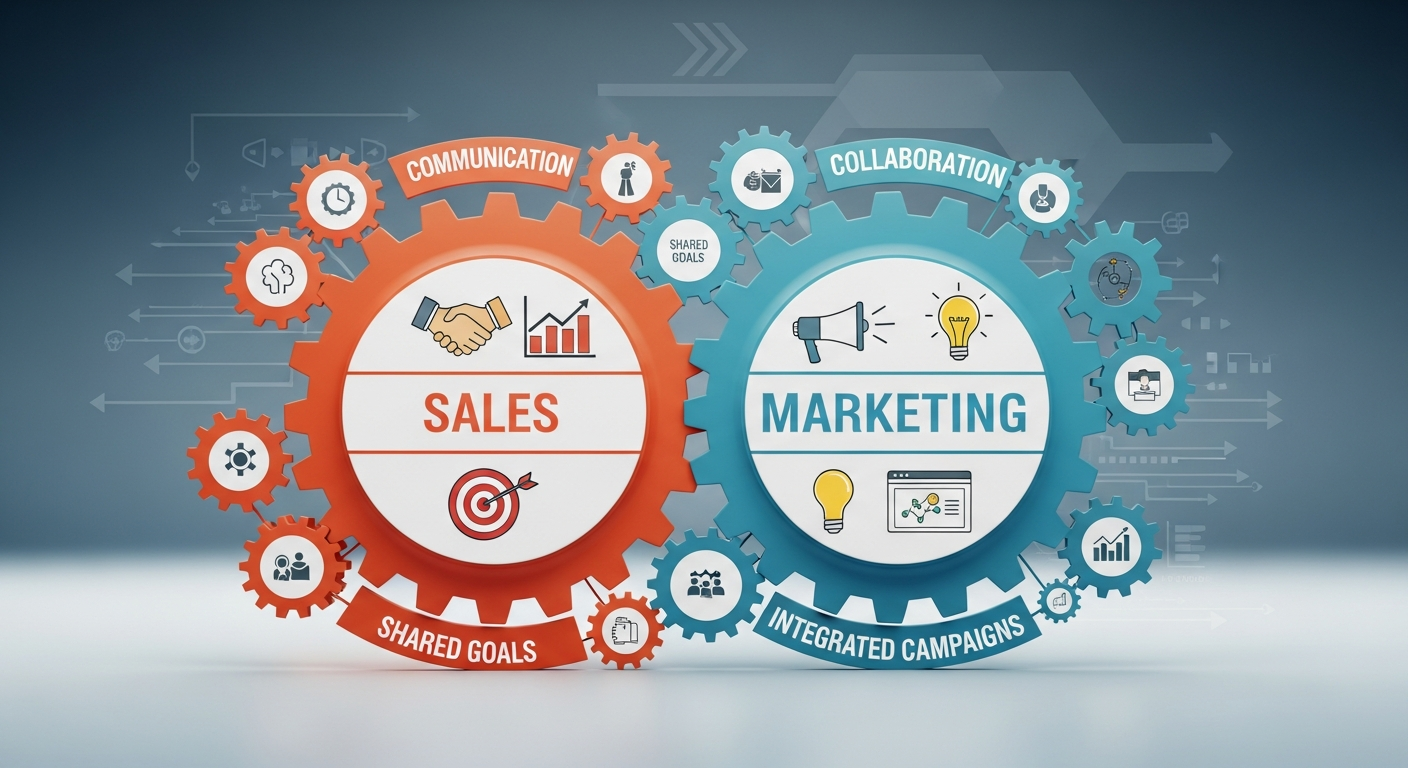
Inbound marketing works best when sales and marketing teams are aligned. Both teams should share common goals, definitions, and processes for managing leads. Clear agreements on what qualifies a lead, when it should be handed off to sales, and how follow-ups occur ensure a smooth customer experience. Alignment improves communication, reduces friction, and increases conversion rates. Marketing delivers better-qualified leads, while sales provides feedback that improves future campaigns. When sales and marketing operate as a unified system, inbound marketing becomes more powerful, driving consistent growth and stronger customer relationships.
Next Steps for Your Business
Inbound marketing is a long-term strategy that builds on itself. By consistently creating valuable content and optimizing each stage of the funnel, you create a sustainable system for generating high-quality leads. It shifts your marketing from a costly interruption to a welcome conversation, building trust and driving growth.
Start by identifying your ideal customer and the problems they face. From there, you can begin to brainstorm content ideas that will attract them to your website. Begin with a single blog post or a simple lead magnet—every small step contributes to building a powerful lead generation engine.
Conclusion
Inbound marketing transforms how businesses attract and retain customers by focusing on value, trust, and meaningful engagement. By guiding prospects through the stages of Attract, Convert, Close, and Delight, brands can build lasting relationships instead of relying on disruptive tactics. When executed consistently, inbound marketing becomes a sustainable growth engine that delivers qualified leads, loyal customers, and long-term business success.
Frequently Asked Questions (FAQ)
1. What makes inbound marketing different from traditional marketing?
Inbound marketing focuses on attracting customers through helpful, relevant content instead of interrupting them with ads. It builds trust by solving problems customers are already searching for.
2. How long does it take to see results from inbound marketing?
Inbound marketing is a long-term strategy. While early traffic gains may appear within a few months, consistent leads and sales typically develop over time with ongoing effort.
3. Do I need a large budget to start inbound marketing?
No. Inbound marketing can start small with a blog, basic SEO, and a single lead magnet. As results grow, you can gradually expand your strategy.
4. What types of businesses benefit most from inbound marketing?
Inbound marketing works well for B2B and B2C businesses, service providers, SaaS companies, and eCommerce brands—especially those with longer buying cycles.
5. Is inbound marketing effective without social media?
Yes. While social media helps amplify content, inbound marketing can still succeed through SEO, blogging, email marketing, and lead nurturing alone.
Frequently Asked Questions (FAQ)
1. What makes inbound marketing different from traditional marketing?
Inbound marketing attracts customers through helpful, relevant content instead of interrupting them with ads. It builds trust by solving problems customers are already searching for.
2. How long does it take to see results from inbound marketing?
Inbound marketing is a long-term strategy. While early traffic gains may appear within a few months, consistent leads and sales typically develop over time with ongoing effort.
3. Do I need a large budget to start inbound marketing?
No. Inbound marketing can start small with a blog, basic SEO, and a single lead magnet. As results grow, you can gradually expand your strategy.
4. What types of businesses benefit most from inbound marketing?
Inbound marketing works well for B2B and B2C businesses, service providers, SaaS companies, and eCommerce brands—especially those with longer buying cycles.
5. Is inbound marketing effective without social media?
Yes. While social media helps amplify content, inbound marketing can still succeed through SEO, blogging, email marketing, and lead nurturing alone.
6. What role does content play in inbound marketing?
Content is the foundation of inbound marketing. Blogs, videos, guides, and emails educate prospects, answer questions, and guide them through the buying journey.
7. How does inbound marketing generate leads?
Inbound marketing generates leads by offering valuable resources—such as ebooks or webinars—in exchange for contact information through forms and landing pages.
8. Is inbound marketing suitable for startups?
Yes. Inbound marketing is ideal for startups because it is cost-effective, scalable, and focused on long-term growth rather than short-term advertising spend.
9. How does SEO support inbound marketing?
SEO helps inbound content appear in search results when potential customers look for solutions, increasing visibility and attracting qualified organic traffic.
10. Can inbound marketing work alongside paid advertising?
Yes. Paid ads can complement inbound marketing by promoting high-performing content and lead magnets, while inbound builds long-term organic growth.
11. How do you measure inbound marketing success?
Success is measured through metrics such as website traffic, conversion rates, lead quality, customer acquisition cost, and long-term customer retention.

